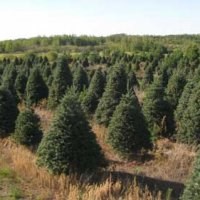Buy Local, Buy Real are a couple of slogans you may have noticed if you are looking for a real Christmas tree to grace your home this holiday season.
I am a fan of the "real" thing. Although over the years, Norfolk Pine and other plants have been used as our Christmas tree depending on where we spent the holidays, but never have we succumbed to purchasing a fake tree. Somehow it just seems wrong. Artificial Christmas trees are generally made from plastic and metal and are manufactured in other countries other than Canada. They will not break down naturally so could fill our landfills sites for centuries.
On the prairies, we do have a relatively small market of growers at this time. However I understand there is a shortage of trees that are available in this market across North America. Before 2015, there were always trees left over that were not sold. Not the case now as there are fewer trees available due to a number of factors. Most that are in the business of selling will be sold out of their product. Most of the trees that are sold in Saskatchewan are imported from eastern Canada, British Columbia and the United States. Some will be of good quality, while others will be of extremely poor quality and thus have played a large role in affecting the perspective of using a real Christmas tree. The most popular Christmas trees sold are most definitely the fir trees with their soft needles, great scent and good retention of needles.
In Canada, there are almost 70,000 acres dedicated to the production of Christmas trees and a related $91.2 million of cash receipts for growers in 2017. Did you know that every acre of Christmas trees produces enough oxygen for 18 people? Think about buying local and buying a real Christmas tree this year and support real jobs for Canadians from the growers, to those they employ as farm hands and the related industries such as transportation, equipment supply to the retail sales of these trees.
Unfortunately, there are a couple more statistics that relate to this industry. Although almost $50 million in export sales of Christmas trees were recorded in 2017, the corresponding import of artificial trees into Canada for the same time period is almost $61 million, with almost $60 million coming from China.
For tree farmers, it takes many years to produce a high-quality Christmas tree. Growers generally produce the trees from seed, and for the first few years are grown in a nursery bed. In about the third year, they are transplanted to the tree farm and then pruned and studiously attended to until they are harvested.
Once a tree is planted out it takes an additional seven to eight years to grow a nicely shaped tree to the desired two metres in height. Ray Gaudet from Gaudet Tree Farms ,which is located close to Prince Albert, states that in Saskatchewan you are looking at an average of 12 years before any tree is marketable and for that period you need to touch that tree each and every year to get the quality needed for market. Thanks to Gaudet Farms for supplying the photo for this week of their tree plantation.
Make this the year that you enjoy the scent of a “real” tree and create some lovely Christmas memories. Watch next week for more particulars on the care that is taken each and every year by growers so you can have a beautiful Christmas Tree.
Hanbidge is the lead horticulturist with Orchid Horticulture. Find us at ; by email at [email protected]; on facebook @orchidhort and on instagram at #orchidhort.
��




